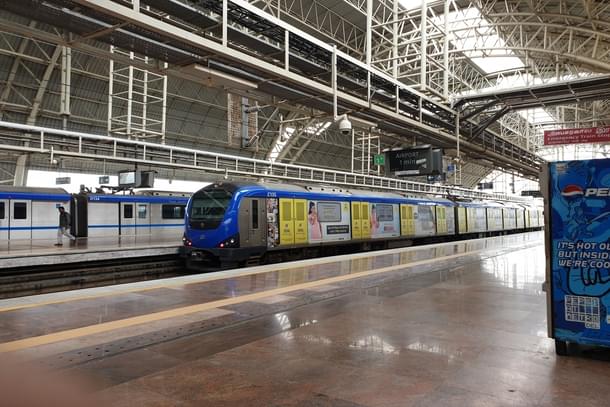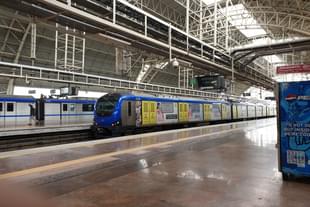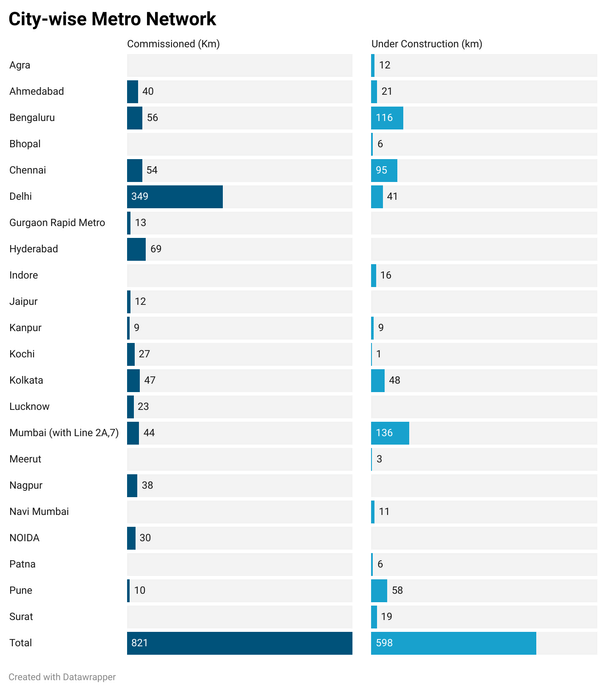Infrastructure
Expanding Footprint Of Metro Rail In India - A Tracker On Ongoing Projects
Amit Mishra
Jan 13, 2023, 05:44 PM | Updated Jan 14, 2023, 10:42 AM IST
Save & read from anywhere!
Bookmark stories for easy access on any device or the Swarajya app.


With Prime Minister Narendra Modi set to inaugurate Line 2A and 7 of the Mumbai Metro on 19 January, a "metro revolution" is happening in the country with the number of cities having the transport network rising to 20 from five in 2014.
The ubiquitous Metro trains running along the landscape of Indian cities is steadily emerging as one of the best solutions for urban transportation.
Metro Rail started in the early 1970s and the first Metro Rail stretch was commissioned in the Kolkata city in 1984 between Esplanade and Bhowanipur, covering a distance of 3.40 km with five stations under Metro Railway, Kolkata. At Present, 27 cities have either Operational or Under Construction Network.
City-Wise Indicators
Around 810 km of metro lines are operational in 20 cities across the nation. More than 980 km of the metro network are currently under construction in 27 cities, according to Union Minister for Housing and Urban Affairs Hardeep Puri.
The Delhi Metro which completed 20 years of its operation on 25 December 2022 is the largest operational network in the country. The metro spans a length of 349 kms with 254 stations spread across 10 lines.
The second largest operational network is Hyderabad Metro which comes a distant second with a length of 69 km followed by 56 km in Bengaluru, 54 km in Chennai and 44 km In Mumbai (once line 2A and 7 are opened).
See the analysis below to understand the spatial distribution of metro network across Indian cities:

New Projects on The Block
Success of Delhi-NCR metro brought enthusiasm in the state governments and they want to replicate the same in the cities with population of over 1 million. Many metro corporations are actively working to bring new areas on the Metro map.
The cities that have lined up their plans include Pune, Nagpur, Ahmedabad, Chennai, Indore, Bhopal, Patna and Hyderabad.
Many state governments are also funding new projects using their own resources since urban transportation is a state subject. The state government of Rajasthan announced the construction of Phases 1C and 1D while expanding the Jaipur Metro in the budget for the fiscal year 2022–2023.
Similarly, Airport Express Metro in Hyderabad is a Rs 6,250 crore Telangana state government funded project. This 31-km-long metro rail line will start at Mindspace junction - an IT hub in the western Hyderabad and end at the city’s international airport located at Shamshabad in southern Hyderabad.
Metro Lite
Cities with a well spread-out spatial pattern, even if they have a high population, may not have sufficient number of corridors with adequate density to justify investments in a metro.
As such state governments have been requested to adopt Metro Lite as a prime mode of mass transit in smaller cities.
This system which can be constructed at a cost of about 40 per cent of high-capacity metro system is more viable and sustainable due to less capital, operation and maintenance costs.
As of now, four Metro Lite Projects are under various stages of implementation ( see the following table):

Metro Neo
MetroNeo which is a rubber-tyred electric coach powered by overhead traction system running on a road slab with an exclusive right of way, is a suitable alternative for tier-2 cities.
It will provide a similar experience and ease of travel in terms of comfort, convenience, safety, reliability and can be developed at a cost of about 25 per cent of conventional metro system.
Currently two MetroNeo projects are under various stages of appraisal and approval. They include:

What Lies Ahead
Metro construction has continued in recent years as a response to increasing urbanisation, environmental challenges and aspirations to a better quality of life, with most growth concentrated in mega cities of the country.
Indian cities are expanding at a rapid pace, both in terms of size and number.
From 35 million plus and 5,161 towns in 2001, it has grown to 53 million plus and 7,933 towns in 2011. As per 2011 census, 31.2 per cent (i.e., 377 million) of India’s population lived in urban areas and by 2050 more than 50 per cent of the country’s population will be urban.
Thus, it is imperative that we should strive to bring newer tier-2 cities on the metro map and extend the coverage in existing cities with adequate provisions foo last-mile connectivity.
Also Read: 20 Years Of Delhi Metro: India’s Greatest Infrastructure Story





